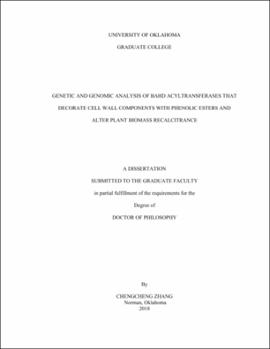| dc.description.abstract | Next generation biofuels make use of the energy stored in plant cell walls, so called lignocellulosic biomass. However, the natural resistance of plant cell walls against deconstruction, i.e., “cell wall recalcitrance”, poses a significant challenge to large-scale commercialization of lignocellulosic biofuels. Grasses, including cereal crops and perennial grasses, are the major source of terrestrial biomass. Previous studies have implicated phenolic acids (ferulic acid and p-coumaric acid) in grass cell wall recalcitrance, but the enzymes that attach these molecules to cell wall precursors are largely unknown. To address this gap, this dissertation accomplished the following: 1) genetic characterization of two so-called “BAHD” acyltransferase genes from rice (Oryza sativa, Os), OsAT5 and OsAT9; 2) examination of the impact of feruloylated lignin on biomass recalcitrance; 3) exploration of cell wall recalcitrance genes in the bioenergy crop, switchgrass, via transcriptomics.
To study the enzymes involved in FA decoration in cell walls, we overexpressed a BAHD -coenzyme A acyltransferase, encoded by the OsAT5 gene, in rice and found increased incorporation of feruloyl monolignol conjugates (ML-FAs) in lignin. Cell wall chemical and gene sequence phylogenetic analysis of gymnosperms, dicotyledonous and monocotyledonous plants revealed that incorporation of ML-FAs is wide-spread in angiosperms, but those orthologous genes to OsAT5 are only present in grasses and other commelinid monocot species. These results suggest that angiosperms have convergently evolved the ability to synthesize this newly recognized conjugated lignin precursor.
To verify the enzymatic activity and the role of OsAT5 in cell wall decoration, we heterologously expressed the OsAT5 gene in yeast and Arabidopsis, which naturally lack monolignol ferulates. Contrasting the cell wall properties of wild type and transgenic OsAT5 overexpression-rice (Ubipro-OsAT5) and -Arabidopsis (C4Hpro-OsAT5) revealed that, 1) transgenic Arabidopsis exhibited reduced cell wall recalcitrance, whereas transgenic rice lines did not; 2) compared with transgenic rice, transgenic Arabidopsis has a more significant impact on sinapyl ferulate (S-FA) incorporation; 3) when treated with alkaline, wild-type rice lignin, which naturally possesses ML-FA conjugates, shows a higher solubility than wild-type Arabidopsis lignin, consistent with grasses having a more chemically-labile lignin polymer than dicots. The discordant observations in rice and Arabidopsis indicate that ML-FAs produced by OsAT5 have differential impacts on cell wall traits depending on the plant species and tissue, raising the possibility of tailoring lignin structure engineering to different species to tune biomass recalcitrance.
To reveal other mechanisms of feruloylation in grasses, we genetically characterized another BAHD acyltransferase, OsAT9, in rice. Overexpression of OsAT9 in rice with the maize Ubi promoter increased the ratio of ferulic acid to p-coumaric acid (FA:pCA) in cell wall polysaccharides and improved extractability of xylan with base treatment, but reduced the enzymatic digestibility of the leaf and stem. These results suggest that OsAT9 is a strong candidate as a feruloyl arabinosyl transferases responsible for feruloylation of rice arabinoxylan by which biomass recalcitrance can be altered.
The important agricultural and industrial use of the perennial grass, switchgrass, has generated particular interest in dissecting biomass digestibility-related genes. To accomplish this, we conducted RNA sequencing of four switchgrass genotypes with distinct digestibility, including four sample types (whole elongation 4-stage tiller, leaf, soft stem, and hard stem). The transcriptomes allowed dissection of tissue-specific, lignin biosynthesis- and biomass digestibility-associated genes. We discovered that some protein kinases and cell wall biosynthesis genes are highly related to biomass digestibility and also noted subfunctionalization of putative cell wall-decorating BAHD acyltransferase and lignin biosynthesis genes.
This dissertation significantly expands knowledge of cell wall decoration by ferulates, provides insight into the functions of BAHD acyltransferase gene family members and their impacts on cell wall synthesis and biomass recalcitrance in both model plants and food and energy crop species. This study also provides valuable information and new ideas for plant breeding and engineering to create less recalcitrant plant biomass for industrial use and animal forage. | en_US |
